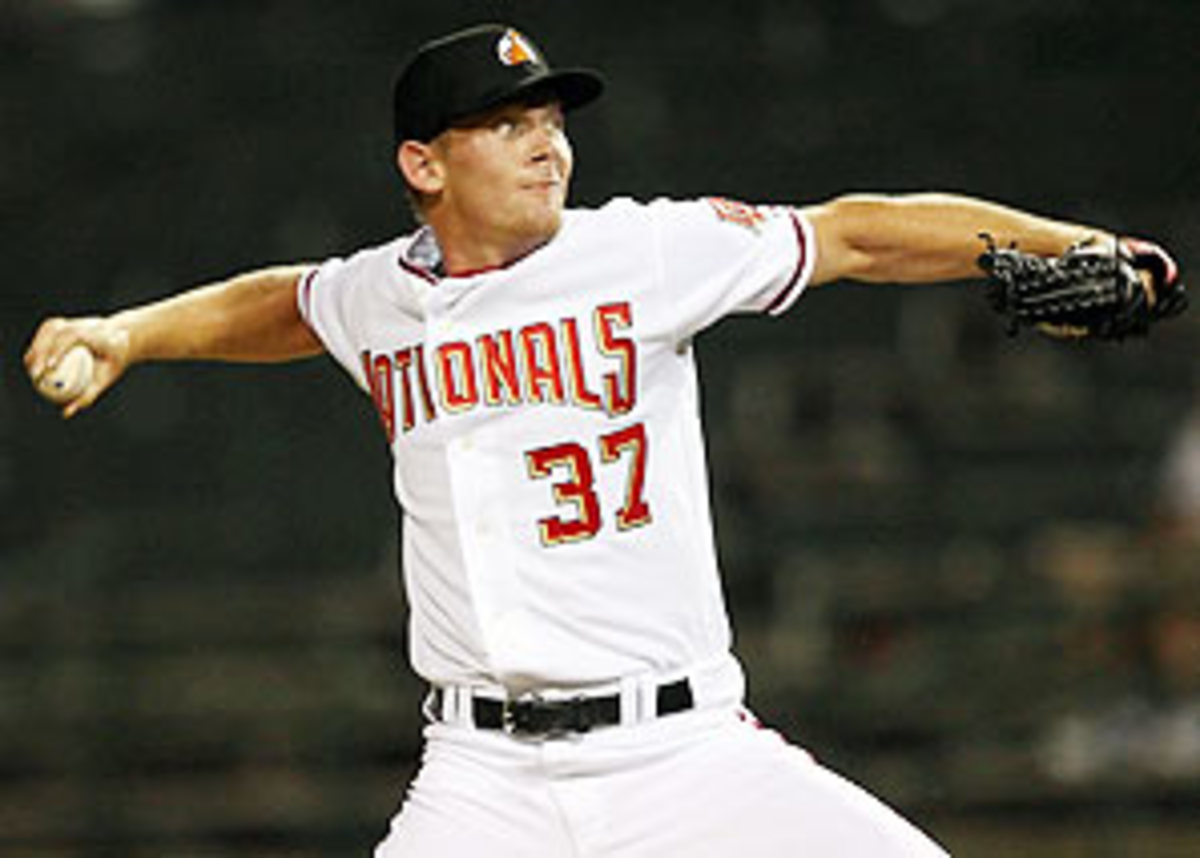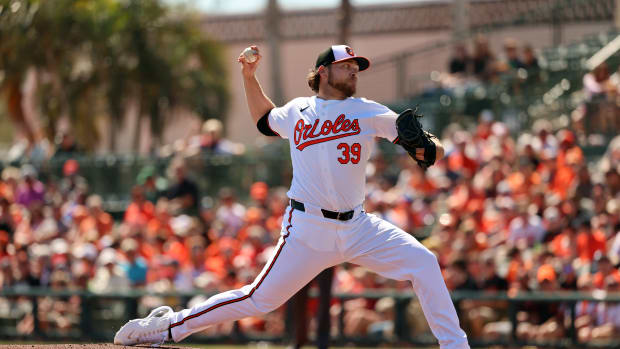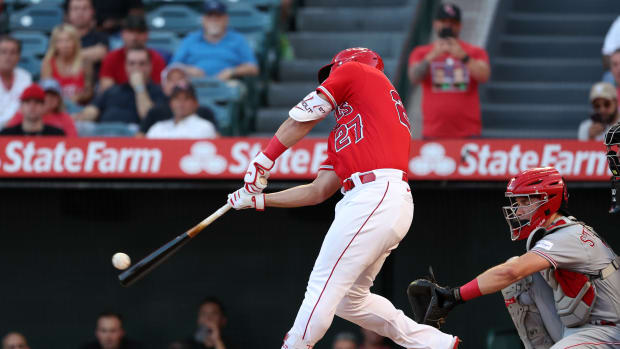
Baseball America: Top 20 prospects
Why he's here: The No. 1 overall pick in the 2009 draft showed why he has all that hype, showing three premium pitches in the Arizona Fall League. His fastball reaches 100 mph, his slider has devastating power and movement, and his changeup has flashes of brilliance, even at 90 mph.
What he'll be: The face of the Nationals and a No. 1 starter.
When he arrives: The Nats will be tempted to push their best arm to the majors quickly but should be able to resist until the second half of 2010 at the least. If he's not in the majors on Opening Day 2011, it will be a major upset.
Why he's here: The 2009 Minor League Player of the Year has exceptional hitting skills, making consistent, hard contact and showing impressive power. He's evoked comparisons to Dave Parker with his overall athleticism and long, powerful frame.
What he'll be: The Atlanta native is poised to take Chipper Jones' mantle as the Braves' franchise player, starting with hitting in the No. 3 hole.
When he arrives: Unless Atlanta brings in a corner outfielder this offseason, Heyward should hit his way into the lineup in 2010.
Why he's here: No one in the minors combines Stanton's athletic ability and physicality with his sheer power.
What he'll be: Stanton is a bigger, stronger version of Marlins special assistant Andre Dawson. He has 40-homer potential and fits the right-field profile perfectly.
When he arrives: The Marlins haven't been shy about promoting prospects aggressively, but Stanton struggled a bit in Double-A last season. If he struggles at first in his first big league action in 2010, don't give up on him.
Why he's here: Once he stayed healthy for a full season, Jennings showed true five-tool talent. He has size, speed, strength, explosiveness and skills.
What he'll be: Jennings has many similarities to current Rays center fielder B.J. Upton, but his hitting track record is more consistent.
When he arrives: The Rays have an outfield spot open presently for 2010, and Jennings should be a big league-ready, inexpensive solution.
Why he's here: The minors' best hitter, Montero gets compared to Mike Piazza as a catcher whose hitting tools far outstrip his defense. The Yankees don't see him as Jorge Posada's heir because his defense is on par with Piazza's or worse.
What he'll be: Because he's likely to move out from behind the plate, Montero should be a first baseman or DH primarily. Other ex-catchers with premium bats such as Paul Konerko and Carlos Delgado leap to mind.
When he arrives: New York's offseason moves will dictate whether Montero spends all season at Triple-A Scranton/Wilkes-Barre or moves up to the big leagues as a part-time catcher and DH.
Why he's here: The minors' most polished pitching prospect threw 40-plus innings in the majors and showed impressive secondary stuff and a feel for changing speeds.
What he'll be: If Matusz keeps hitters honest enough with his fastball, he could give the Orioles their best starting pitcher since Mike Mussina's departure.
When he arrives: He already did last year, but in 2010 Matusz will get to play a support role to veteran Kevin Millwood.
Why he's here: When Alvarez gets hot, he goes nuclear. He has impressive power and can go on home run binges, and he still is athletic enough to play a capable third base early in his career.
What he'll be: Alvarez has a chance to follow the Jim Thome career path as an early-career power-hitting third baseman who eventually settles in as a mashing first baseman.
When he arrives: Not soon enough for the Pirates, who could use some pizzazz. Alvarez looked capable in Double-A but might have his arbitration clock delay his big league debut until midway through 2010.
Why he's here: Feliz has one of baseball's quickest, most electric arms, and showed it off when he first was called up to the major leagues last August.
What he'll be: The big question with Feliz is his ultimate role. Before tiring down the stretch last year, Feliz showed he could be an impact relief arm, and his feel for his secondary stuff comes and goes. The Rangers see that easy upper-90s gas, though, and see a starter.
When he arrives: Feliz is expected to break camp in 2010 in Texas' rotation. It might take a while for him to truly arrive as a starter, as was the case for flamethrowers such as Edwin Jackson and A.J. Burnett.
Why he's here: The 2008 College Player of the Year, Posey combines athletic ability and hitting prowess with playing a premium position.
What he'll be: Remember Russell Martin before Joe Torre played him 150 games a year? Posey may not have Martin's fiery leadership, but he'll be a similar catcher with better hitting ability.
When he arrives: As soon as he shows he can receive effectively for pitchers such as Brian Wilson and Matt Cain, who have premium velocity. Then he'll have to take it up another notch to handle Tim Lincecum.
Why he's here: No pitcher has had Bumgarner's sheer results the last two seasons, when he went 27-5. He did it in 2009 with diminished velocity but it didn't seem to matter as he mowed down Double-A competition at 19.
What he'll be: Bumgarner's mound presence and ability to pitch off his fastball evokes Cliff Lee. He has similar mound presence and could match Lee if he regains some of his slider's lost bite.
When he arrives: The Giants have enough other rotation options to keep Bumgarner on the farm for at least part of 2010, and perhaps until late in the season, when he could get another bullpen cameo.
Why he's here: The Indians just got rid of a switch-hitting, offensive-minded catcher with offensive upside in Victor Martinez. Santana is nowhere near the polished hitter that Martinez was in Cleveland, but his patient, powerful approach should prove there's more than one way to get it done.
What he'll be:: A catcher with 20-homer ability who draws plenty of walks and can control the running game usually makes a few All-Star games.
When he arrives:Lou Marson, acquired from the Phillies in the Cliff Lee trade, should hold down the fort for most of 2010, but Santana could hit his way past Marson sooner than later.
Why he's here: A switch-hitter from the South, Smoak looks a bit like Chipper Jones at the plate with his stance and mannerisms. He has a chance to hit like Jones, too, with consistency, polish and power.
What he'll be: Smoak doesn't quite have Mark Teixeira's explosive power, but he's a similar-caliber hitter and defender. He just needs to add a bit of polish and figure out how to turn on inside pitches.
When he arrives: With Hank Blalock out of the picture, the first-base job is open in Texas. While Smoak has competition, he should become the full-time first sacker by 2011.
Why he's here: The last man standing, at least at Double-A or better, in the Phillies farm system has a body that evokes Darryl Strawberry, with similar speed and defensive tools. He lacks the explosive wrists and power of Strawberry but should hit his share of homers eventually.
What he'll be: Some scouts actually see Brown, who has surprising plate discipline for such a raw player, as more of a top-of-the-order factor than as a middle-of-the-order presence. He's the greenest hitter on this list, but his talent is undeniable.
When he arrives:Raul Ibanez and Jayson Werth are ensconced on the corners in Philadelphia, and Brown needs to polish up his defense anyway. He'll be a minor leaguer in 2010 but could ease Ibanez out by 2011, the last year of the veteran's contract.
Why he's here: Kelly actually hit and pitched in 2009, as he had ability as a shortstop and wanted to hit. His hitting lagged behind his pitching prowess, and after a trip to the Arizona Fall League, Kelly realized his future is on the mound.
What he'll be: Kelly has a knack for adding and subtracting from his fastball and excellent curveball, sometimes toying with hitters. His athletic ability and innate pitchability evoke some comparisons to Zack Greinke, though his arm isn't quite in Greinke's class.
When he arrives: Kelly first needs to prove he can handle a full-season workload as a pitcher. If he proves that in 2010, he should be ready by 2011.
Why he's here: A 6-foot righty from Iowa, Hellickson has surprising stuff and feel for pitching. His changeup has been his best pitch, but his fastball command took a huge step forward in 2009, allowing him to be the ace for Durham's Triple-A championship team.
What he'll be: Yet another homegrown Rays pitcher for a franchise that couldn't develop any pitching in its first six or seven years. Hellickson's curve gives him a third quality pitch, and he gives the rotation another different look to play off Jeff Niemann's size, David Price's electric arm, James Shields' premium changeup and Matt Garza's power.
When he arrives:Wade Davis beat him to the majors, so Hellickson may have to bide his time back at Durham in 2010. His time may have to come after a trade.
Why he's here: The son of 1990 Cy Young Award winner Doug Drabek was the key piece in the Roy Halladay trade and instantly became Toronto's top prospect. His stuff wasn't always consistent in 2009, but at his best he has an excellent curveball, a plus fastball and a decent changeup.
What he'll be: If his changeup gets better, Drabek can be a No. 2 starter on a championship team. If not, he could become a Tom Gordon clone as a closer, bringing mid-90s heat and finishing off hitters with his curve.
When he arrives: Drabek was vulnerable to left-handed hitters last year, and the Blue Jays have pitching depth, so Drabek should be able to move up to Triple-A and hone his changeup in 2010 without having to immediately deal with the burden of being the Player Traded for Roy Halladay.
Why he's here: The Brewers brought up Escobar in August but he didn't surpass 130 at-bats, leaving him prospect-eligible. Then Milwaukee traded J.J. Hardy to the Twins, handing the job to the best defensive player among prospects.
What he'll be: Escobar has the arm, infield actions, hands and range to win Gold Gloves at shortstop. He makes the routine plays and the tough ones, too. Plus, he has speed that impacts the game offensively, and his swing's not so bad either.
When he arrives: Escobar is more prepared than Rangers shortstop Elvis Adrus was last year and should have a bigger impact in 2010.
Why he's here: Five-tool ability to go with the ability to take a walk and premium defensive tools make Hicks an exciting prospect, even if he's never played above Class A.
What he'll be: Hicks has some similarities to the Phillies' Domonic Brown, though he might actually have more speed and a bit less power. He's a tremendous athlete who was a scratch golfer as a teen, so it's hard to put a limit on his talent.
When he arrives: The Twins know what they're doing with raw, toolsy center fielders, having developed Torii Hunter and Denard Span in succession. HIcks is next in line and has more offensive polish at a similar stage.
Why he's here: The No. 2 overall pick in the 2009 draft isn't as explosive as Strasburg, but he was a steady .400 hitter in college who added power as a junior. He was far from overmatched in the AFL, batting .315 while adjusting to a relatively new position, center field.
What he'll be: Ackley has some similarities to Johnny Damon with his athletic ability (though he's not as explosive as Damon was in his prime), plus-plus speed and poor throwing arm, but he might be a better pure hitter than Damon.
When he arrives: Ackley has the bat to move quickly, but a position change could slow him down. Primarily a first baseman in college, he could play center field, left field or even second base.
Why he's here: The third Ranger on the list, Perez has a delivery and repertoire that draw comparisons to Johan Santana. That may not be fair to Perez, but as an 18-year-old, he was the best pitcher in the South Atlantic League, and his compact delivery is a near-duplicate of Santana's.
What he'll be: Well, have we mentioned Santana? There's just a long way for Perez to go from A-ball to the majors, and his workload has been handled very carefully so far.
When he arrives: Let's give Perez a couple of years to let his low-90s fastball that touches 96, plus changeup and plus curveball time to incubate. He should be on this list at least two more times.


































